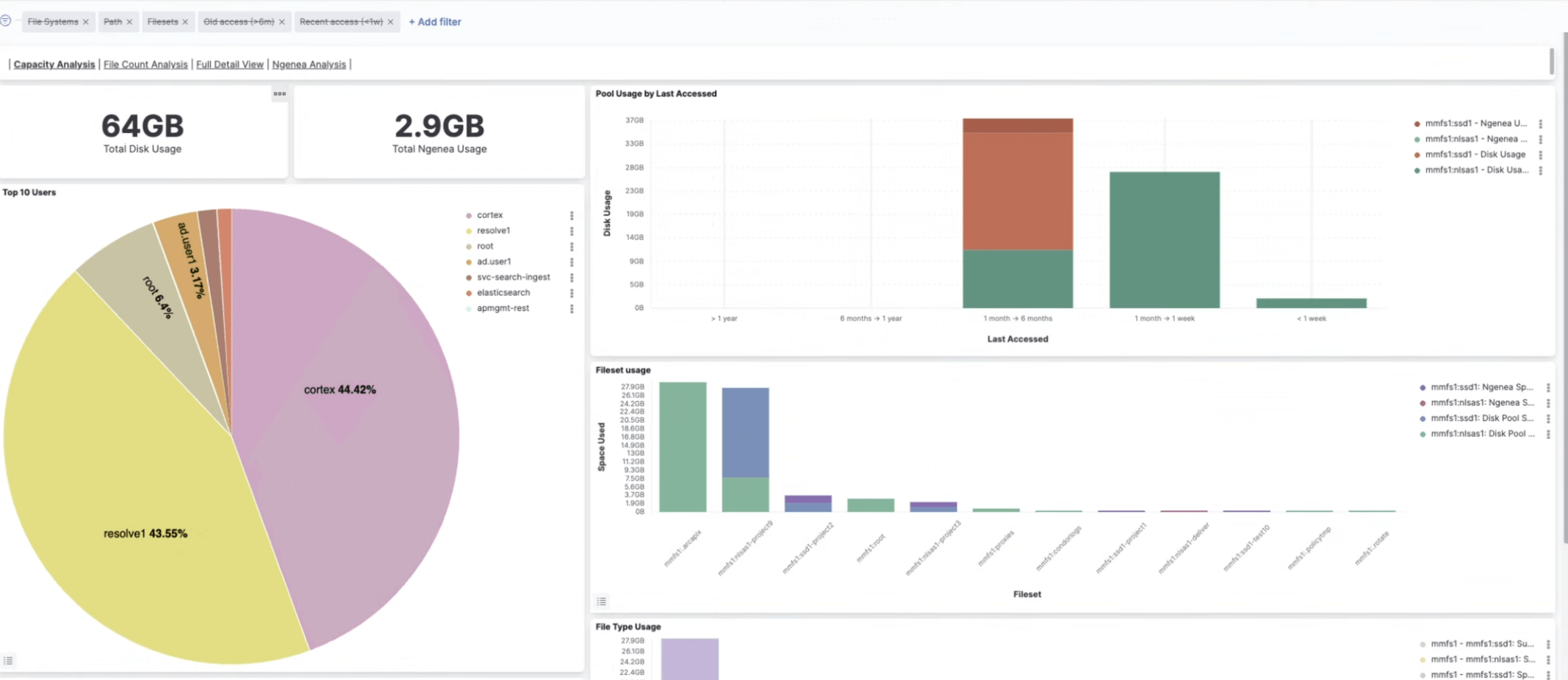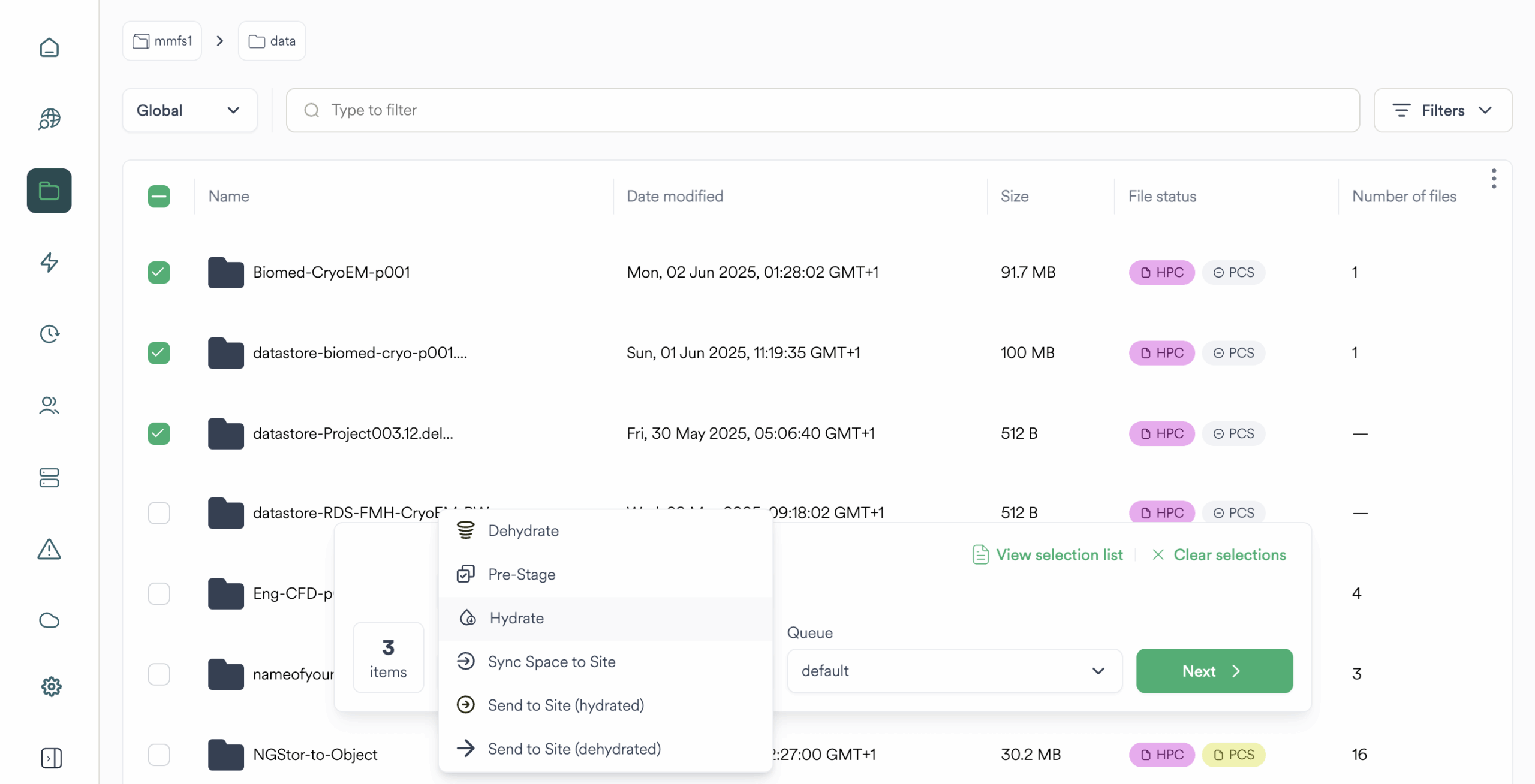I flussi di lavoro ad alta intensità di dati si interrompono sotto pressione quando lo storage tradizionale non riesce a tenere il passo. Che si tratti di addestramento dell'AI, simulazioni HPC o di progetti multimediali ad alta risoluzione, i colli di bottiglia delle prestazioni, la frammentazione del file system e il sovraccarico dei metadati possono arrestare i progressi.
Pixstor è un file system software-defined scalabile orizzontalmente ad alte prestazioni con funzionalità NAS. Offre un throughput costante, bassa latenza e accesso multiprotocollo trasparente, supportando workload misti, un numero elevatissimo di file e casi d'uso impegnativi senza compromessi. Con il tiering intelligente dei dati e un namespace unificato, Pixstor semplifica la gestione garantendo al contempo che i dati siano sempre gestiti velocemente, accessibili e sicuri.
- Supporta qualsiasi tecnologia di storage: NVMe, SSD, SAS, NL-SAS e così via
- Offre supporto multiprotocollo tra cui SMB, NFS, SFTP, POSIX, S3, NVMe-oF
- Scala da ambienti terabyte a multi-petabyte con miliardi di file
- Offre prestazioni fino a 180 GB/s in un fattore di forma 4U
- Progettato per prestazioni a piena velocità anche con un utilizzo della capienza del 99%
- Consente accesso rapido ai dati, ricerca dei file e controllo del ciclo di vita
- Deployment on-premise o nel cloud, con supporto per flussi di lavoro ibridi
Casi d'uso
Workload HPC che richiedono un'elaborazione rapida e parallela e l'accesso a set di dati di grandi dimensioni a velocità di I/O estreme
Ambienti di addestramento AI/ML che richiedono un accesso rapido e a bassa latenza a set di dati di grandi dimensioni da cluster GPU
Workload per le scienze biologiche e la genomica, con processi paralleli di sequenziamento, scansione e analisi
Editing video con elevata velocità di trasferimento dati e rendering VFX in pipeline multimediali e di intrattenimento
File system sicuro e multi-tenant per team creativi o gruppi di ricerca con accesso e quote controllati
Organizzazioni che sostituiscono NAS legacy o file system scalabili orizzontalmente che non sono in grado di mantenere le prestazioni su larga scala
Funzionalità
Pixstor è un file system parallelo ad alte prestazioni, conforme a POSIX, pensato per gestire miliardi di file in modo preciso, efficiente e sotto pieno controllo. Il suo namespace globale unificato e l'architettura di metadati distribuita eliminano i colli di bottiglia supportando al contempo ambienti a protocollo misto su larga scala.
- Namespace unificato per tutti i tipi di disco, tier e posizioni
- Policy a livello di file per quote, ACL, snapshot e metadati
- Accesso multiprotocollo simultaneo: NFS, SMB, SFTP, POSIX, S3
- Supporta NVMe-oF e GPUDirect per percorsi dati ultra veloci e a bassa latenza dallo storage ai nodi di calcolo e alle GPU
- Isolamento del namespace attraverso la segmentazione logica a livello di progetto (per esempio, Fileset)
- Caching locale che accelera l’accesso ai dati “caldi” o frequentemente riutilizzati
- Supporto nativo per miliardi di file e directory
- Ottimizzato per blocchi di grandi dimensioni (fino a 8 MB) senza compromettere le prestazioni per i file di piccole dimensioni
Pixstor automatizza il posizionamento intelligente dei dati con policy di tiering granulari che spostano i dati tra i livelli di prestazioni e capienza senza interrompere i flussi di lavoro o le autorizzazioni di accesso.
- Tiering basato su policy in base all'età, alle dimensioni, all'ora di accesso, alla posizione, al proprietario o ai tag dei file
- Tiering trasparente su NVMe, SSD, HDD, che può essere esteso a object storage, cloud pubblico, nastro e altri sistemi di storage con DataCore Ngenea
- Spostamento trasparente dei dati mantenendo percorsi di accesso e autorizzazioni
- Quando vi si accede, i file vengono richiamati in modo trasparente dai tier inferiori
Le snapshot e i cloni in Pixstor sono leggeri e costruiti per la scalabilità, consentendo un rollback rapido, ambienti di test e scenari di ripristino completo tra i siti.
- Snapshot copy-on-write con impatto minimo sulle prestazioni
- Cloni di snapshot scrivibili per flussi di lavoro di staging, test o temporanei
- Integrazione delle Versioni Precedenti di Windows per punti di ripristino accessibili dall'utente
- Conservazione delle snapshot con versione nelle destinazioni di backup
- Set di backup montabili per l'accesso immediato al DR
- Replica site-to-site e sincronizzazione del DR utilizzando la tecnologia snapshot-diff
Il motore di ricerca di Pixstor va oltre i nomi dei file per consentire deep discovery, aggiunta di tag e automazione utilizzando metadati e analisi dei contenuti su tutti i tier, anche offline o su set di dati archiviati.
- Indicizzazione integrata di metadati e contenuti con Pixstor Search
- Indicizzazione degli attributi dei file (nome, dimensione, proprietario), del contenuto (EXIF, testo) e dei tag AI/ML
- Aggiunta di tag personalizzati ai metadati tramite attributi estesi (xattrs)
- Ricerca e anteprima su dati aggiornati in tempo reale, archiviati e remoti
- Exportable risultati per editorial or pre-staging workflows
- Carrello di ricerca attiva: cerca → seleziona → agisci (copia, sposta, archivia)
- Accessibile tramite interfaccia web o API programmabile
Pixstor ottimizza l'utilizzo dello storage con la compressione in linea e la logica di deduplica intelligente che identifica i contenuti ridondanti e ne riduce l'ingombro senza influire sulle prestazioni.
- Compressione in linea al momento della scrittura
- Decompressione trasparente in fase di lettura
- Identificazione basata su policy dei file duplicati in base ai risultati della ricerca
La sicurezza è integrata in Pixstor a ogni livello, dall'accesso basato sui ruoli alla crittografia e alla segmentazione a livello di tenant, garantendo che i dati siano sempre protetti e conformi.
- Controllo degli accessi in base al ruolo (RBAC) per una gestione granulare degli utenti
- Container NAS sicuri con dati completi, metadati e isolamento degli accessi
- Autenticazione tramite Active Directory, LDAP, OKTA e OAuth2
- Policy di immutabilità e conservazione dei dati che utilizzano snapshot e applicazione delle ACL
- Rollback basato su snapshot per scenari di ripristino e audit
- TLS, crittografia SSH in transito e crittografia opzionale at rest
- Isolamento per tenant per l'accesso, i percorsi di rete e gli ambiti di applicazione delle policy
Pixstor include osservabilità e automazione integrate, offrendo visibilità e controllo completi dalla dashboard alla CLI fino ai flussi di lavoro programmatici.
- Metriche in tempo reale per larghezza di banda, latenza, CPU e lunghezza della coda
- Analisi I/O per client e a livello di protocollo
- Logstash/Elasticsearch integrati per eventi e avvisi
- Log centralizzati e audit trail per eventi e operazioni sui file
- Notifiche e-mail per eventi e soglie di sistema
- Hook di automazione basati su file (per esempio, il rilascio di un file attiva un processo)
- SaltStack per la configurazione del sistema e il controllo della versione
- Automazione del ciclo di vita tramite interfaccia web, REST API e Python SDK
- Compatibile con gli scheduler di workload come Slurm tramite accesso POSIX/NFS
Insieme a Ngenea, Pixstor supporta i flussi di lavoro basati su cloud, consentendo una gestione trasparente dei dati basata su tiering, ricerca e policy su storage on-premise e cloud.
- Accesso agli oggetti compatibile S3, compresa l'integrazione nativa con DataCore Swarm
- Tiering trasparente da e verso AWS, Azure, GCP e altri object store
- Flussi di lavoro ibridi con caching intelligente e logica push/pull
- Ricerca e anteprima tra tier cloud e on-premise
- Hook di policy per applicare l’uso dei tier in base a costi e regole di conservazione
Benefici
Accelera i tempi di ottenimento dei risultati
- Riduce i ritardi di avvio del processo con l'accesso istantaneo ai set di dati
- Precarica i dati in modo intelligente per i flussi di lavoro di calcolo
- Elimina i colli di bottiglia legati allo storage nelle pipeline critiche
Lavora in modo più intelligente con l'automazione
- Imposta e dimentica le policy del ciclo di vita in base all'utilizzo reale
- Sposta automaticamente i dati tra storage veloce e profondo
- Riduci la gestione manuale dei file e le attività basate su supposizioni
Trova ciò che cerchi, velocemente
- Niente più ricerche tra i sistemi: una visione unificata di tutti i file
- Ricerca per progetto, utente o tag anche se i dati sono archiviati
- Ricerca attiva: copia, sposta, archivia in un solo passaggio
Costi più bassi senza compromessi
- Mantieni lo storage costoso concentrato sui dati attivi
- Massimizza il ROI utilizzando hardware di base
- Costi chiari e prevedibili: paghi solo ciò che utilizzi, scali liberamente in base alle necessità e senza sorprese o costi nascosti
Protegge i dati senza rallentamenti
- Snapshot e DR integrati nativamente, non semplici componenti aggiuntivi
- Mantiene gli utenti produttivi garantendo al contempo la conformità
- Ripristina rapidamente i file senza necessità di chiamare l'IT
Si collega a qualsiasi flusso di lavoro
- Funziona con le app, i flussi di lavoro e l'infrastruttura esistenti
- Si integra con gli scheduler di processo e le pipeline
- Nessun lock-in imposto dai vendor: i dati rimangono sotto controllo
Architettura
Architettura di riferimento DataCore Pixstor e Ngenea per ambienti HPC/AI
Deployment
Il deployment di Pixstor e Ngenea può essere realizzato on-premise, nel cloud o come soluzione ibrida, offrendo la flessibilità necessaria per supportare qualsiasi flusso di lavoro o strategia infrastrutturale.
Licensing
Pixstor utilizza un modello di licenza per unità, basato sul numero di drive NVMe o SAS utilizzati. Non sono previsti addebiti per terabyte o supplementi in base ai tier. Questo approccio supporta configurazioni flessibili in termini di prestazioni e capienza multi-tier, mantenendo i costi prevedibili anche quando il sistema cresce.


